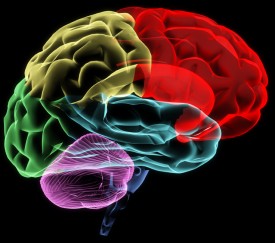
It’s Brain Awareness Week! To celebrate, we’ve put together a few fun facts about the brain and how it learns. Share them and spread the word about why good nutrition, sleep, and learning habits matter.
1) True/False: Dreams are useless.
False! Research has found that when learning a new task, people who have dreams related to the task may actually improve their performance.
In one study at Harvard Medical School, students were asked to navigate a difficult maze, starting at a different point in the maze each time. During a break, one group of students was asked to nap while another group remained awake. Students in the nap group who dreamed about the maze performed better the next time they tried the maze, while those who dreamed about other things or who stayed awake did not improve.
Dreaming can take place during both REM and non-REM sleep. REM stands for “rapid eye movement” because the dreamer’s eyes move around under their eyelids during this phase of sleep. REM is the phase of sleep during which dreaming typically occurs, and dreams during REM sleep tend to be wild and illogical. But dreams can also take place during non-REM sleep. These dreams are often more thoughtful and logical than REM dreams and appear to be more important for learning.
2) True/False: Your brain functions best on Crimini mushrooms and beef brains.
True - though mushrooms and beef brains may be extreme examples of what keeps your brain working at its best. Still, good food choices do more than help your body grow, repair itself, and fight off illness. Food choices have an effect on how well your brain works, too.
Neurons, the cells of the brain, have a fatty coating called myelin that helps impulses move quickly from cell to cell. Your brain needs the right combination of proteins and fats from food sources to create myelin and to build new connections between neurons. Your brain’s ability to create new connections is closely tied to its ability to keep up in class and to learn new things.
The brain also relies on neurotransmitters to relay impulses from neuron to neuron. Neurotransmitters are the brain’s chemical messengers, and different neurotransmitters are built from different starter materials. An example of one of these starter materials is tryptophan, a substance found in a variety of healthy foods including shrimp, Crimini mushrooms, tuna, spinach, eggs, soybeans, broccoli, and cow’s milk. The body needs tryptophan to make serotonin, a neurotransmitter that is linked to learning, memory, and motivation.
In the spirit of brain awareness week, we discovered that beef brains are actually a lean source of protein. But if you're like us, you'll stick with the chicken, turkey and fish!
3)True/False: Your brain is competitive. With itself.
True. The human brain has incredible potential. People have successfully trained their brains to perform amazing feats of memory and computation, monks have learned to alter their body temperature by controlling their brain waves with meditation, and people with brain damage have regained lost abilities that we used to think were irreversible.
You’ve probably heard the expression “use it or lose it,” which means that we lose skills when we don’t practice them in daily life. That’s because the brain actually restructures itself based on how we use it most often, and those structural changes affect our performance. We get better at skills that we practice and we lose skills that we neglect. When it comes to student learning, “use it or lose it” is very real – especially during the summer months.
Say, for example, that a student reads 30 minutes every day during the school year. Then summer vacation rolls around and without the structure of school he reads only 30 minutes each week. His brain is going to think that he doesn’t need all of those neural connections for reading anymore, and it will actually change the way that his neurons are connected and devote them to other activities that he’s engaged in more often – say, playing sports or watching TV. This is called competitive plasticity.
That’s great for the time he spends with friends for summertime fun, but not so great come fall when it’s time to head back to class. Many kids lose ground in reading over the summer, and even more kids lose skills in math. Over time, these losses add up. In fact, student achievement in the 12 thgrade is closely tied to what kinds of learning activities students engage in during the summer. Students who are high performers at high school graduation have typically spent time during their summers maintaining or increasing their academic skills.
It’s Not Too Soon
Have you shared the facts of “summer slide” with your students so they understand why you might want them to read or practice their math skills? If not, start beating the drum today for summer learning, and when the summer months roll around, perhaps your students will actually spend time doing those things that challenge their brains to learn and grow.
Fun Stuff
Try our Brain Awareness Week activities in the classroom as a fun way to extend the learning:
The Learning Brain Word Search– Basic words for lower grades.
The Learning Brain Word Match– More advanced words for higher grades.
References:
Cromie, W.J. (2002, April 18). Meditation changes temperatures: Mind controls body in extreme experiments. Harvard University Gazette. Retrieved from http://news.harvard.edu/gazette/2002/04.18/09-tummo.html
Mateljan, G. (2006). The World's Healthiest Foods: Essential Guide for the Healthiest Way of Eating. World’s Healthiest Foods.
Nutrition and the Brain. (n.d.). In Neuroscience for Kids. Retrieved from http://faculty.washington.edu/chudler/nutr.html
Ornes, S. (2010, May 11). Dreaming makes perfect. ScienceNews for Kids. Retrieved from http://www.sciencenewsforkids.com.php5-17.dfw1-2.websitetestlink.com/wp/2010/05/dreaming-makes-perfect-2/
For further reading:
Official Brain Awareness Week Website
Related reading:
The Reading Brain: How Your Brain Helps You Read, and Why it Matters
How Learning to Read Improves Brain Function

